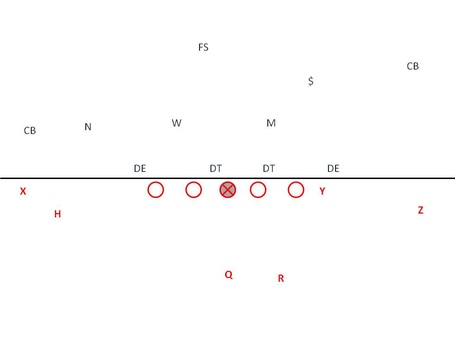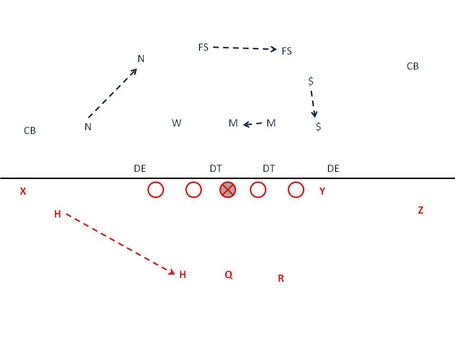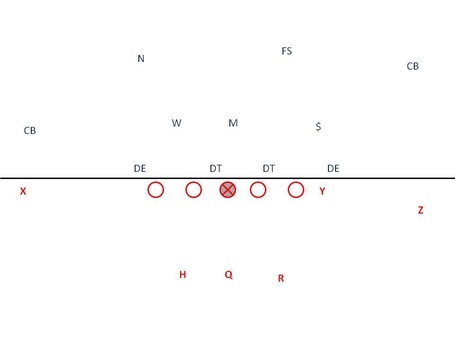Inside the Playbook: Ohio State's Two-Back Offense (PREVIEW)
LINK to full article.
In 2013, Ohio State had one of the best run offenses in the nation. Part of their success came from two-back sets, or more accurately, by motioning a slot receiver - their Percy Harvin role - into the backfield. Losing, in my opinion, the best college RB in football last year, but returning the dynamic Braxton Miller and all their Harvinites, two back sets will likely become more prominent in this year's offensive iteration. In this piece, we will look at why these sets are so difficult for defenses to defend, both from a pre-snap standpoint, and after the snap.
Pre-snap Dilemma
The Buckeyes base set will present four vertical threats. Often times, this will be with 11 personnel, with two split ends, a slot, an H-back, and a RB. At times Meyer will deploy more of a true TE look, and involve a flanker and slot or show a trips type set.
Motioning 11 personnel or 10 personnel to 21 or 20 personnel presents a very different look for defenses. Let me explain.
From 11 personnel, the offense has four vertical threats, along with maintaining a horizontal threat and the potential overloading one side of the field.
Most likely, in this circumstance, the defense will be forced to utilize a nickel look. On top of that, a cover 3 defense can be exploited in multiple ways, most dangerously, with four verts. So defenses are forced to communicate and make adjustments in order to mitigate the potential dangers these four vertical threats bring to the table. Nick Saban's matchup zone is the product of his Cleveland Browns team's Cover 3 being exploited by four verticals from the Pittsburg Steelers. Mattison adjusts his Cover 3 by having the flat defender (typically the "Backer" or "Buzz" leverage defending LB) align directly over the #2 and carry him deep and "Freeze" against a trips look (align over #2 and read through #3, to put it simply).
But now a slot motions into the backfield on the opposite side of the QB. You're defense has made all their calls, adjustments, and communication, and suddenly they are presenting with a completely different set of threats, especially in the run game.
All your old option plays, and wide variety of run situations, now come into play. Your Cover 3 or Cover 4 must now adjust appropriately to a new look. Perhaps you change your leverage call to a nub formation (for example adjust Cover 3 to what I term "Cover 5", which is a three deep coverage with a "cloud" CB leverage perhaps; adjust your Cover 4 to a quarter-quarter-half Cover 6). So it's all new communication and checks that need to be made in a hurry, and all new threats that you have to quickly pop into your mind with the new look. But you have to have personnel that can cover both, and be smart enough to adjust to both looks quickly.
Two-Back Run Game
Now we will simply look at the different run plays that OSU will deploy from a two back set. We'll briefly describe the theory behind each play, and how they work in concert with the whole, but to keep this post somewhat in check, we'll keep it fairly succinct.
In 2013, Ohio State had one of the best run offenses in the nation. Part of their success came from two-back sets, or more accurately, by motioning a slot receiver - their Percy Harvin role - into the backfield. Losing, in my opinion, the best college RB in football last year, but returning the dynamic Braxton Miller and all their Harvinites, two back sets will likely become more prominent in this year's offensive iteration. In this piece, we will look at why these sets are so difficult for defenses to defend, both from a pre-snap standpoint, and after the snap.
Pre-snap Dilemma
The Buckeyes base set will present four vertical threats. Often times, this will be with 11 personnel, with two split ends, a slot, an H-back, and a RB. At times Meyer will deploy more of a true TE look, and involve a flanker and slot or show a trips type set.
Motioning 11 personnel or 10 personnel to 21 or 20 personnel presents a very different look for defenses. Let me explain.
From 11 personnel, the offense has four vertical threats, along with maintaining a horizontal threat and the potential overloading one side of the field.
Most likely, in this circumstance, the defense will be forced to utilize a nickel look. On top of that, a cover 3 defense can be exploited in multiple ways, most dangerously, with four verts. So defenses are forced to communicate and make adjustments in order to mitigate the potential dangers these four vertical threats bring to the table. Nick Saban's matchup zone is the product of his Cleveland Browns team's Cover 3 being exploited by four verticals from the Pittsburg Steelers. Mattison adjusts his Cover 3 by having the flat defender (typically the "Backer" or "Buzz" leverage defending LB) align directly over the #2 and carry him deep and "Freeze" against a trips look (align over #2 and read through #3, to put it simply).
But now a slot motions into the backfield on the opposite side of the QB. You're defense has made all their calls, adjustments, and communication, and suddenly they are presenting with a completely different set of threats, especially in the run game.
All your old option plays, and wide variety of run situations, now come into play. Your Cover 3 or Cover 4 must now adjust appropriately to a new look. Perhaps you change your leverage call to a nub formation (for example adjust Cover 3 to what I term "Cover 5", which is a three deep coverage with a "cloud" CB leverage perhaps; adjust your Cover 4 to a quarter-quarter-half Cover 6). So it's all new communication and checks that need to be made in a hurry, and all new threats that you have to quickly pop into your mind with the new look. But you have to have personnel that can cover both, and be smart enough to adjust to both looks quickly.
Two-Back Run Game
Now we will simply look at the different run plays that OSU will deploy from a two back set. We'll briefly describe the theory behind each play, and how they work in concert with the whole, but to keep this post somewhat in check, we'll keep it fairly succinct.
* * * * * * *
Follow the link to Maize n Brew to learn more about the Inverted Veer package, Read Option, Triple Option, and Sail Passing Concept that Ohio State will utilize out of their two-back set.






Comments
Post a Comment